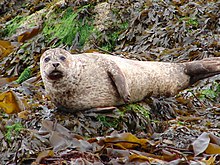| Northern seals | |
|---|---|

| |
| Harbor seal, Phoca vitulina | |
| Scientific classification | |
| Domain: | Eukaryota |
| Kingdom: | Animalia |
| Phylum: | Chordata |
| Class: | Mammalia |
| Order: | Carnivora |
| Clade: | Pinnipedia |
| Family: | Phocidae |
| Subfamily: | Phocinae Gray, 1821 |
| Tribes and genera | |
| |
Phocinae (known colloquially as "Northern seals") is a subfamily of Phocidae whose distribution is found in the seas surrounding the Holarctic, with the Baikal seal (Pusa sibirica) being the world's only freshwater species of pinniped.[1] What distinguishes them from other phocid seals is the presence of well-developed claws on their front and back flippers.[2][3] The Phocinae is divided into three extant tribes: Erignathini (represented by the sole extant bearded seal Erignathus barbatus), Cystophorini (another extant monotypic tribe represented by hooded seal Cystophora cristata), and Phocini (represented by the rest of the other surviving species in the subfamily). Members of both Erignathini and Cystophorini have 34 chromosomes, while species in the tribe Phocini have 32 chromosomes.[2]
Below is a composite phylogeny of the phocine genera after Berta & Churchill (2012),[4] Dewaele et al. (2018),[5] and Koretsky & Rahmat (2013):[6]
| Phocinae |
| ||||||||||||||||||||||||||||||
- ^ Reeves, R. R.; Stewart, B. S.; Clapham, P. J.; Powell, J. A. (2002). Seals and Sea Lions of the World. New York: Alfred A. Knopf. pp. 1–528. ISBN 0375411410.
- ^ a b Bonner, N. (1994). Seals and Sea Lions of the World. United Kingdom: Blandford. pp. 1–224. ISBN 9780816057177.
- ^ Stewart, Brent (2014). "Family Phocidae (Earless Seals)". In Wilson, D.E.; Mittermeier, R.A. (eds.). Handbook of the Mammals of the World – Volume 4. Barcelona: Lynx Ediciones. pp. 120–183. ISBN 978-84-96553-93-4.
- ^ Berta, A.; Churchill, M. (2012). "Pinniped taxonomy: Review of currently recognized species and subspecies, and evidence used for their description". Mammal Review. 42 (3): 207–34. doi:10.1111/j.1365-2907.2011.00193.x.
- ^ Dewaele, Leonard; Lambert, Olivier; Louwye, Stephen (2018). "A critical revision of the fossil record, stratigraphy and diversity of the Neogene seal genus Monotherium(Carnivora, Phocidae)". Royal Society Open Science. 5 (5): 171669. Bibcode:2018RSOS....571669D. doi:10.1098/rsos.171669. PMC 5990722. PMID 29892365.
- ^ Koretsky, I. A.; Rahmat, S. J. (2013). "First record of fossil Cystophorinae (Carnivora, Phocidae): Middle Miocene seals from the northern Paratethys". Rivista Italiana di Paleontologia e Stratigrafia. 119 (3): 325–350.